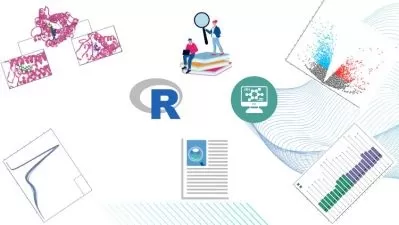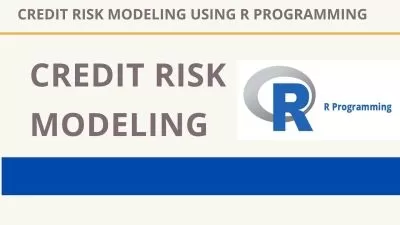R programming for Beginners
Wrikki Lahiri
3:18:53
Description
Fundamentals of R programming and data visualisation and statistical analysis in R for beginners
What You'll Learn?
- Students will learn the fundamentals of R programming
- Students will learn how to write functions, loops and conditional statements
- Students will learn data visualisation in R
- Students will learn Statistics in R
- Students will learn how to write code in R
- Students will gain knowledge about R syntax and language
Who is this for?
What You Need to Know?
More details
DescriptionThe "R Programming for Beginners" course covers a wide range of fundamental topics related to learning and using the R programming language for data analysis and visualization. Here's a breakdown of the main topics covered in the course:
1. **Installing R software:** Students learn how to install the R programming environment on their computers, which is the first step in getting started with R.
2. **Basic syntax:** The course covers the basic syntax of the R language, which includes understanding how to write and execute simple R commands.
3. **Variable definition:** Students learn how to create and manipulate variables to store data and values in R.
4. **Operators in R:** This topic covers various types of operators in R, including arithmetic, comparison, and logical operators.
5. **Conditionals:** Students learn how to use conditional statements (if-else) to make decisions in their R programs based on certain conditions.
6. **Loops:** The course covers different types of loops (such as for loops and while loops) that allow students to repeat tasks and operations.
7. **Functions:** Students learn how to define and use functions in R, which allow them to encapsulate code into reusable blocks.
8. **Data structures:** The course introduces various data structures in R, such as vectors, matrices, data frames, and lists.
9. **Visualization of data:** Students learn how to create visualizations using R to represent data graphically.
10. **Descriptive statistics:** The course covers essential descriptive statistics, including measures like mean, median, standard deviation, and more.
11. **Statistical analysis:** Students are introduced to statistical techniques like correlation, linear regression, and logistic regression for analyzing relationships and making predictions from data.
12. **Data interfaces:** The course likely covers how to import data from CSV and change working directory.
The overall goal of the course is to provide beginners with a solid foundation in R programming and data analysis techniques. By the end of the course, students will be able to write and understand R code, write programs using loops, conditional statements and functions, create data visualizations, and conduct statistical analyses.
At the end of the course there is a final project that will help people practise what they have learnt. This project requires students to analyse data, allowing students to practically apply their knowledge, bolstering their skills and confidence. This emphasis on real-world application ensures students can adeptly handle data analysis tasks beyond the course.
Who this course is for:
- Beginners who want to learn R programming language
- Beginners who want to learn R syntax
- Beginners who want to learn how to write code in R
- Beginners who want to learn how to visualise data in R
- Beginners who want to learn how to use R for statistics
- Beginners who want to learn the building blocks of programming such as loops, functions and conditional statements
The "R Programming for Beginners" course covers a wide range of fundamental topics related to learning and using the R programming language for data analysis and visualization. Here's a breakdown of the main topics covered in the course:
1. **Installing R software:** Students learn how to install the R programming environment on their computers, which is the first step in getting started with R.
2. **Basic syntax:** The course covers the basic syntax of the R language, which includes understanding how to write and execute simple R commands.
3. **Variable definition:** Students learn how to create and manipulate variables to store data and values in R.
4. **Operators in R:** This topic covers various types of operators in R, including arithmetic, comparison, and logical operators.
5. **Conditionals:** Students learn how to use conditional statements (if-else) to make decisions in their R programs based on certain conditions.
6. **Loops:** The course covers different types of loops (such as for loops and while loops) that allow students to repeat tasks and operations.
7. **Functions:** Students learn how to define and use functions in R, which allow them to encapsulate code into reusable blocks.
8. **Data structures:** The course introduces various data structures in R, such as vectors, matrices, data frames, and lists.
9. **Visualization of data:** Students learn how to create visualizations using R to represent data graphically.
10. **Descriptive statistics:** The course covers essential descriptive statistics, including measures like mean, median, standard deviation, and more.
11. **Statistical analysis:** Students are introduced to statistical techniques like correlation, linear regression, and logistic regression for analyzing relationships and making predictions from data.
12. **Data interfaces:** The course likely covers how to import data from CSV and change working directory.
The overall goal of the course is to provide beginners with a solid foundation in R programming and data analysis techniques. By the end of the course, students will be able to write and understand R code, write programs using loops, conditional statements and functions, create data visualizations, and conduct statistical analyses.
At the end of the course there is a final project that will help people practise what they have learnt. This project requires students to analyse data, allowing students to practically apply their knowledge, bolstering their skills and confidence. This emphasis on real-world application ensures students can adeptly handle data analysis tasks beyond the course.
Who this course is for:
- Beginners who want to learn R programming language
- Beginners who want to learn R syntax
- Beginners who want to learn how to write code in R
- Beginners who want to learn how to visualise data in R
- Beginners who want to learn how to use R for statistics
- Beginners who want to learn the building blocks of programming such as loops, functions and conditional statements
User Reviews
Rating
Wrikki Lahiri
Instructor's Courses
Udemy
View courses Udemy- language english
- Training sessions 39
- duration 3:18:53
- Release Date 2023/08/24










